Results show the number of lice on salmon offered diatom feed were statistically and significantly lower
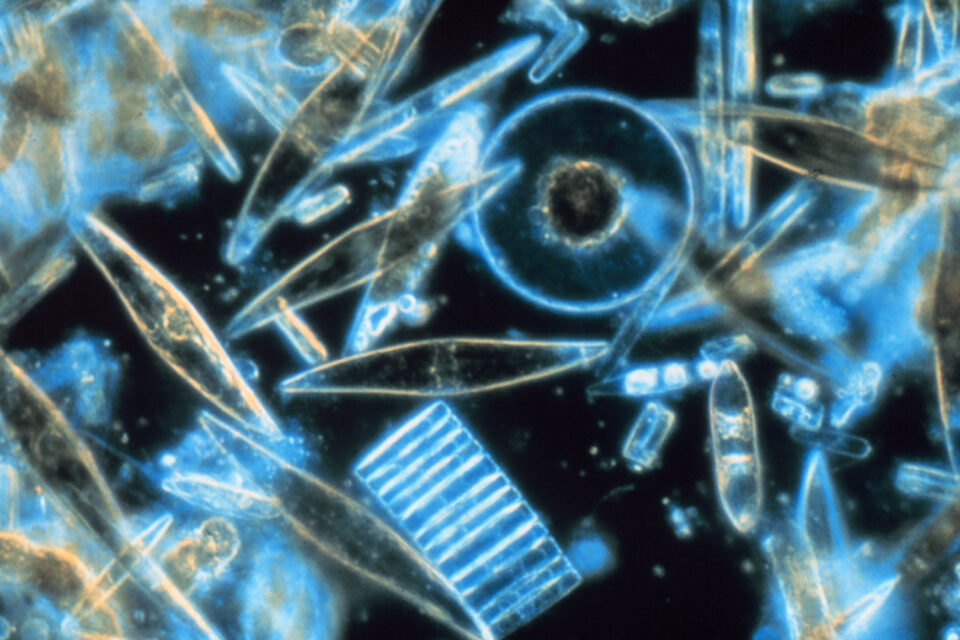
The salmonid aquaculture industry in Norway experiences significant challenges relating to environmental impacts, fish health, escape from pens and salmon lice. The latter can cause disease and reduce growth, and at high concentrations, it can even cause death. In order to protect wild salmonid stocks and farmed fish, it will be necessary to reduce lice infestations. Therefore, the Norwegian government has issued strict regulations, i.e., a maximum prevalence of 0.2 female lice per fish during spring is allowed.
This has triggered the development and use of several delousing methods – chemical, mechanical and biological (cleaner fish). The delousing methods have in fact increased already too high mortality in Norwegian salmon aquaculture. The use of cleaner fish often has, if any, very short-lived effects. The annual total cost of delousing in Norway now has passed NOK 6 billion (U.S. $676 million), not including losses related to reduced growth and exaggerated mortality.
The inclusion of marine oil in Norwegian fish feed has decreased in recent years as marine ingredients have gradually been replaced with alternatives, primarily of terrestrial agricultural origin. This has led to reduced long-chain polyunsaturated fatty acid (LC-PUFA) ratios in farmed salmon. Research and industrial development should thus give priority to re-introducing marine LC-PUFAs in salmon feed as well as to reduce mortality related to delousing, not only for economic reasons but also to improve fish welfare.
Photoautotrophic [organisms that use light energy and inorganic carbon to produce organic materials] marine diatoms are good candidates as they grow fast (>100 percent increase in biomass/day) and contain high levels of the PUFAs eicosapentaenoic acid (EPA) and docosahexaenoic acid (DHA), in addition to substantial amounts of amino acids, vitamins and other functional substances. Microalgae production also has clear advantages in terms of ecological footprint (energy, carbon dioxide) relative to conventional fish feed ingredients.
The use of feed with microalgae to deter salmon lice is based on a hypothesis generated many years ago. We originally observed that both intake of feed and lice infestation on salmonids decreased at the same time as the phytoplankton (microalgae) spring bloom progressed. We assumed this to be caused by a phytoplankton toxin, and it was later confirmed that the reason was an oxylipin [oxygenated natural product formed from fatty acids] produced by the microalgae Phaeocystis pouchetii. Since salmon lice are copepods [small crustaceans], we hypothesized that the inclusion of diatoms in the fish feed could reduce lice infestation. To test this we offered four diets of different origins to salmon, including one with diatoms, and monitored lice infestation.
This article – adapted and summarized from the original publication (Eilertsen H.C. et al. 2021. Inclusion of photoautotrophic cultivated diatom biomass in salmon feed can deter lice. PLoS ONE 16(7): e0255370) – reports on a study to evaluate the potential of diatom (microalgae) biomass as a lice-reducing ingredient in salmon feed.
Study setup
The experiments were performed at the Aquaculture Research Station in Tromsø, Norway. A total of 450 Atlantic salmon (Salmo salar) juveniles (130 to 140 grams each) from a commercial strain were individually tagged allowed to recuperate for 17 days, and stocked into 12 separate tanks. We used four feed treatments: A-Algae, B-Fish oil, C-Calanus and D-Control, each with three replicates in 500-liter seawater flow-through tanks.
For detailed information, on the experimental design and diets; cultivation of diatom biomass; fish sample collections and various analyses; and statistical analyses, refer to the original publication.
Results and discussion
Our results showed that fish fed diet A-Algae feed had statistically significantly fewer lice (Fig. 1) compared to fish fed the other diet types. The reasons for this may be: i) Differences in general health condition or stress level of salmon groups prior to exposure to salmon lice copepodites may have influenced rate and magnitude of infestation; ii) Variable health may have resulted from differences in chemical composition between the diets; iii) An ingredient present in the diet, may have triggered production of some bioactive compound that influenced lice infestation, i.e., in accordance with our original hypothesis where the active agents were polyunsaturated aldehydes, PUAs [lipid oxidation products generated by various species of diatoms which can reduce copepod fecundity and egg hatching success].
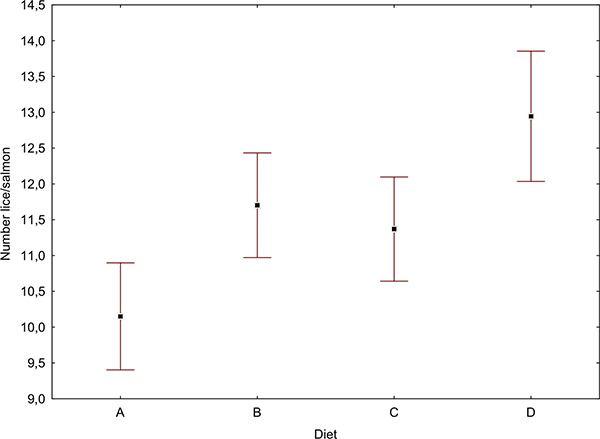
Farmed fish needs lipid, protein, energy, vitamins and minerals to thrive and develop naturally. Here lipids, and especially essential fatty acids of marine origin, are important for normal physiological functions. Salmon in our experiment had specific growth (SGR) rates from 1.29 to 1.44 percent per day during the period (67 days) they were fed the four diets; similar studies by other researchers reported lower growth rates.
All our salmon groups showed good growth for all diets (mean SGR 1.4 ± 0.2 percent/day). Our fish hence performed in the high end of potential growth for salmon at the same weight and temperature. The SGR range between the four diet groups also varied little (1.29 to 1.44 percent/day), and we interpret this as an indication that our fish were at acceptable health compared to what is common in salmon aquaculture.
All our four diets contained 25 percent fishmeal. In addition, diets A, B and C contained ca. 21.3 percent oils of marine origin while diet D had 9 percent marine and 12.3 percent rapeseed oil. Other researchers have reported observing the best growth with the diet that had the largest amounts of fishmeal and marine oil, but growth was unaffected as long as fish oil and fishmeal were above 5 percent, respectively. Also, further growth was correlated to total omega-3 fatty acid content in the diets, irrespectively of the content of individual omega-3 fatty acids. Other investigations where fish oil inclusion in the feed was lower than in our study showed substantially or slightly lower growth rates. The main reason for the good growth performance in our experiment was therefore probably due to the content of marine ingredients.
Our fish fed diet A-Algae had statistically significantly fewer lice (Fig. 1) compared to fish fed the other feed types. We believe it unlikely that this was caused by some general effect of fish health and growth since fish fed all diets performed well and hence appeared to be in good health throughout the experiment. Salmon fed diets A-Algae and D-Control had slightly better growth than diets B-Fish oil and C-Calanus (Fig. 2). Even if these differences were low, they were statistically significant.
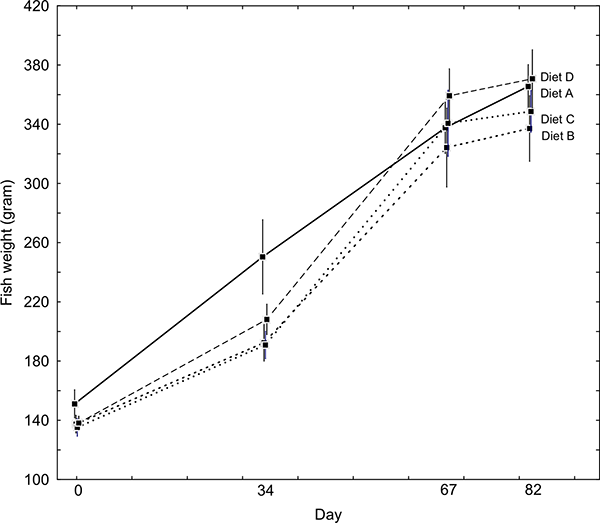
The basis of our original lice hypothesis was that polyunsaturated aldehydes (PUAs) produced by diatoms can function as grazing deterrents and harm copepod development. The formation of free fatty acids in diatoms can be attributed to grazer defense mechanisms, where the fatty acids produce oxylipins. We were not able to detect any meaningful and significant correlation here between diet composition, fillet composition and lice amount.
But if diatoms are the original producer of a compound functioning as a lice deterrent in wild salmon, it is to be expected that it is fed up the food web since zooplankton and small fish are intermediates between primary producers and salmon. Our lice infestation mean values were positively correlated to trophic level, that is, the number of lice increased from diatom feed through Calanus, fish oil to standard feed that had terrestrial ingredients. This may indicate that even if we were not able to detect it; that it was some ingredient/bioactive in the feed that caused variable lice attacks. Skin samples from individuals belonging to the four different feed regimes were analyzed for contents of PUAs, and our results suggest that the lice deterring agent may be a PUA in fat produced in/by the salmon.
Perspectives
Our data showed statistically significantly reduced lice infestation in salmon offered conventional feed with diatom biomass. In our investigation, there were no correlations between feed ingredients and lice infestation. Neither were we able to detect a bioactive compound that was active as a lice deterrent, nor could we relate differences in lice infestation to health differences.
However, the main result that lice infestation was reduced in the salmon group offered diatom biomass still indicates the presence of some active lice deterring ingredient. In addition to that the ingredient may come from the feed, it can also have been synthesized or resulted from chemical reactions in the fish. We therefore strongly recommend further research to get more insight into the potential production and secretion of invertebrate repelling aldehydes in salmon, and that experiments should also take place in open sea pens under natural conditions.
Now that you've reached the end of the article ...
… please consider supporting GSA’s mission to advance responsible seafood practices through education, advocacy and third-party assurances. The Advocate aims to document the evolution of responsible seafood practices and share the expansive knowledge of our vast network of contributors.
By becoming a Global Seafood Alliance member, you’re ensuring that all of the pre-competitive work we do through member benefits, resources and events can continue. Individual membership costs just $50 a year.
Not a GSA member? Join us.
Author
-
Dr. Hans Chr. Eilertsen
Corresponding author
Norwegian College of Fishery Science, UiT The Arctic University of Norway, Tromsø, Norway
Editor’s note: The original article has 13 co-authors.[111,110,46,116,105,117,64,48,48,48,105,101,104]
Tagged With
Related Posts
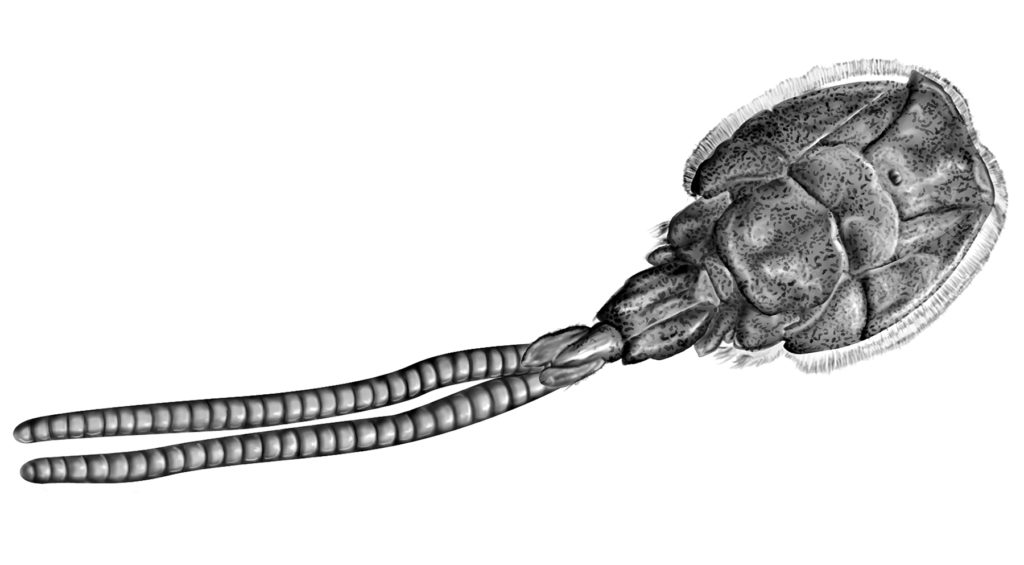
Health & Welfare
Animal health giants have sea lice in their crosshairs
Alltech and Benchmark have been working on the next generation of sea lice solutions and believe they have new products that can help salmon farmers win.
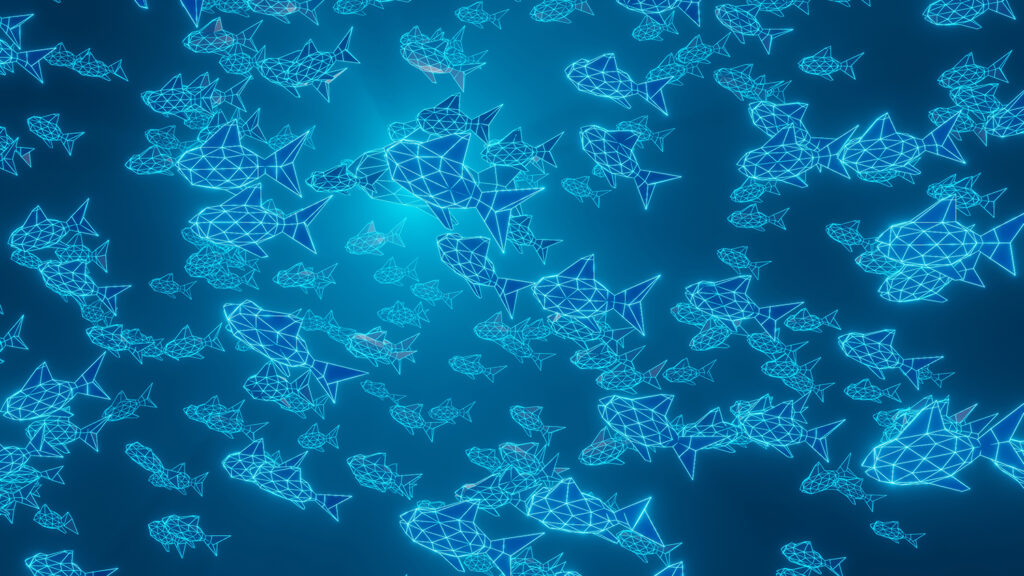
Innovation & Investment
‘AI ticks all the boxes’ and is proving to be a perfect match for aquaculture
Artificial intelligence (AI) is rippling through the aquaculture industry, promising greater efficiencies and insights, as well as investor interest.
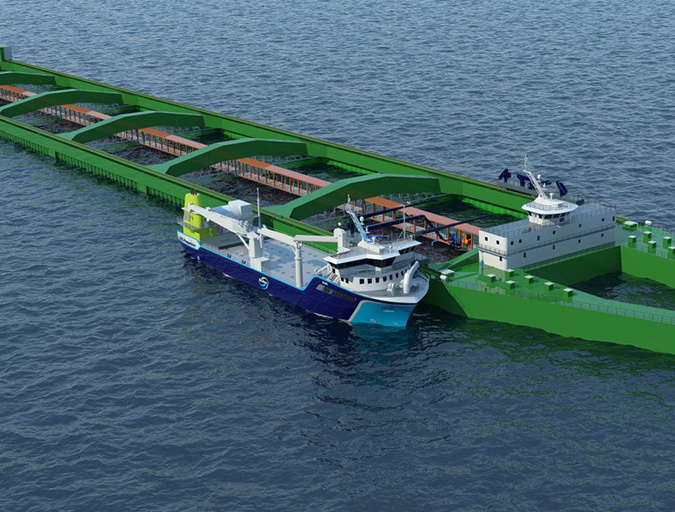
Health & Welfare
Chem-free fixes emerging in sea lice saga
Salmon farmers, using emerging technologies, are exploring new methods of sea lice mitigation in an effort to overcome one of the industry’s most persistent problems. New chemical-free innovations show an industry eager to adapt and adopt environmentally safe practices.
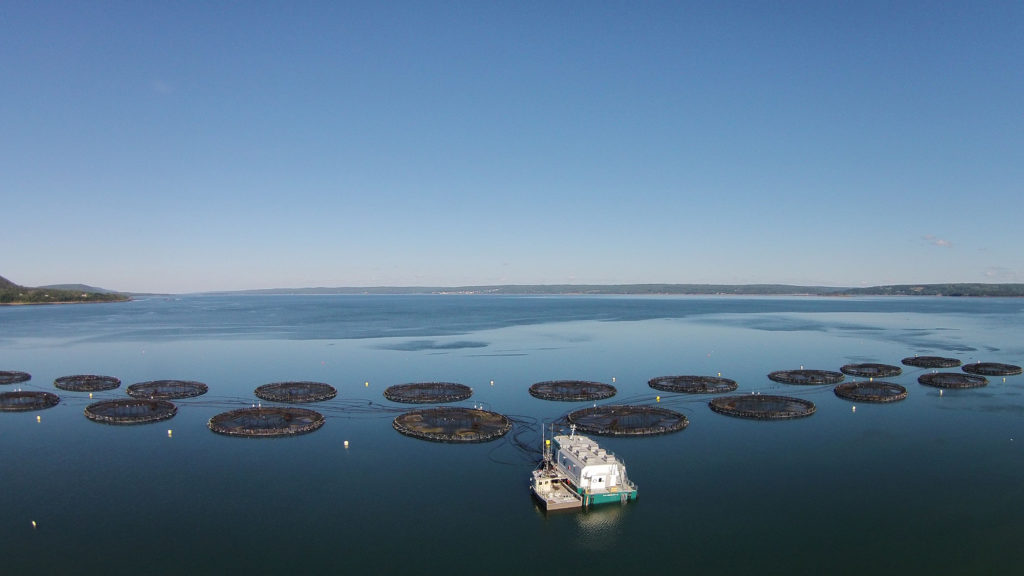
Responsibility
Warming oceans prompt adaptation efforts for aquaculture
A five-year study in Canada aims to provide more answers about warmer waters with lower oxygen levels and a way for farmed fish producers to adapt to climate change.



